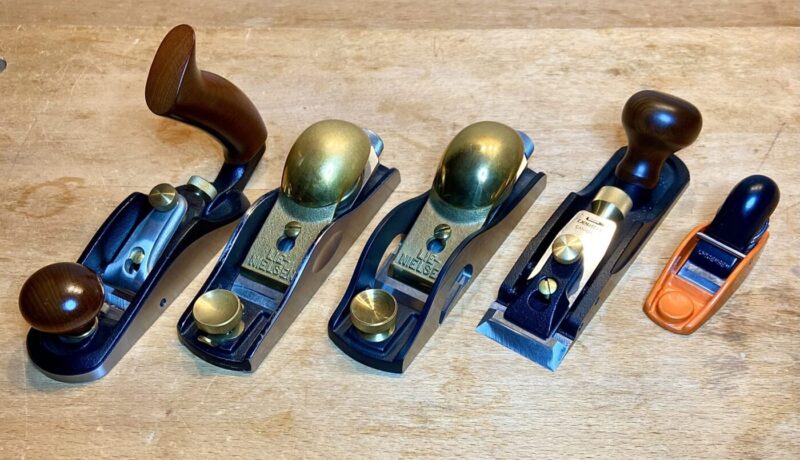
We turn to little planes when the regular big ones, such as the #4 smoothing, #5 jack, and #7 jointer will not do the job or are awkward. These five little planes are worth having in my shop.
Left to right in the photo above:
1. Veritas Bevel-up #1. The blade bed is at 15°. The mouth is adjustable. I sharpen the PM-V11 steel blade at 27.5°/32.5°. The plane is 5 13/16” long, 1 25/32” wide. The blade is 1 7/32” wide, 1/10” thick.
2. Lie-Nielsen #60 1/2 block plane, 12° blade bed, adjustable mouth. I sharpen the W1 blade (an early model) at 27.5°/32.5°. Plane 6 1/4” long, 1 3/4” wide. Blade 1 3/8” wide, 1/8” thick.
3. Lie-Nielsen #60 1/2 rabbet block plane, 12° blade bed. I sharpen the A2 blade at 27.5°/32.5°. Plane 6 1/2” long, 1 3/4” wide. Blade 1 3/4” wide, 1/8” thick.
4. Veritas Cabinetmaker’s Trimming plane, 15° blade bed. I sharpen the O1 blade at 25°/30°. Plane 6 1/2” long, 1 3/4” wide. Blade 1 3/4”+ wide, 1/8” thick.
5. Jorgensen mini block plane #70700, 20° blade bed. I sharpen O1 blade at 25°/30°. Plane 3 1/2” long, 1 1/4” wide. Blade 7/8” wide, 1/8” thick.
The #1 plane functions just like the larger planes but it is handily smaller. For example, it handles very well for smoothing a narrow part of a cabinet frame, even a long one. The handles allow you to hold it and move it just as well as a #4 smoother. I think it is nearly a must. I keep it just as well sharpened as the #4.
The regular block plane works well with one hand pushing in any direction and angle. I use it for practical fitting, trimming, and sizing parts. I think just about everyone has a regular block plane.
The rabbet block plane is the same idea but you can cut to the side edges. So it can fit in length or side joints where it can often out do a chisel. Not essential, but very handy.
The trimming plane can save the day where it is too hard to consistently and accurately use a chisel. For example, where you need to clean up the width and length of a joined corner section. I do not pick it up too often but it saves the day when I need it!
Sure, for #3 and #4, you can often substitute a shoulder plane, edge plane, or others, but these block plane variants have advantages in holding and pushing. There are alternatives, but these have important roles.
The mini block plane: yes, have it and you will quickly use it for all sorts of little tasks. It is incredibly well made – flat, excellent steel blade, easy to adjust well – for $18! You might even keep it in a pocket.
Ok, if you want only two: bevel-up #1 and mini plane. Three? Ok, add the regular block plane. All five?! Ok, skip an expensive restaurant group outing or two. Hey, you’re a woodworker! These are like fingers in the hands and connections in the brain.

I have a little green Kunz rat tailed (or is that a squirrel’s tail?) mini block plane I bought on a trip to Chicago in the early 80s. The little tail changes everything. It’s just so much better and easier to handle. Over 40 years and I still use it most evry day.
Great, Richard, to hear about a little tool with such a lasting use. Almost like a body part that keeps going with you.
Rob I should also add the Lie Nielsen violin makers plane to your list. The blade is a tad narrower than the Kunz equivalent. But, it has a beefier blade, knurled micro adjuster, blade cap with tail and it’s made of solid brass. Lovely feel in hand with all that mass. Bought mine several years ago and if it’s in the LV catalog today I’m sure it’s an order of magnitude pricier!
Hi Richard,
Yes, a great option! Thanks.
I have played with it but do not own it. Tempting! It is only 3-7/16″ long x 1-3/16″ wide, with the bevel-up blade at 20°. It is still available at good old Lie-Nielsen.
Rob
I have all of these. The little Jorgensen plane is an economical favorite. I did however strip all of the orange and black powder coat off of mine…just couldn’t stand the colors. These do have a nice thick iron that sharpened very well. A great little plane for easing edges.
Hi Eric,
Yea, it’s hard to believe the mere $18 bucks for a very nice little plane! I agree, the colors aren’t good. Why does Jorgensen use them? Anyway, the O1 steel does well for that blade, and as always with O1, it is easy to sharpen. And the body is made very nice and accurate.
Sometimes I just don’t need Lie Nielsen or Veritas, which are great, and the low cost stuff does the job just fine. (Of course, some low cost stuff is crap.)
Rob